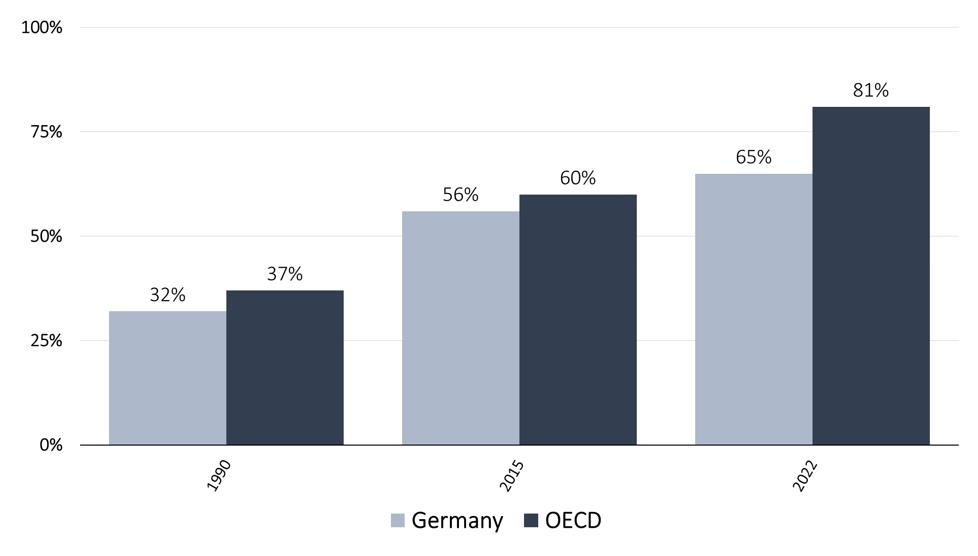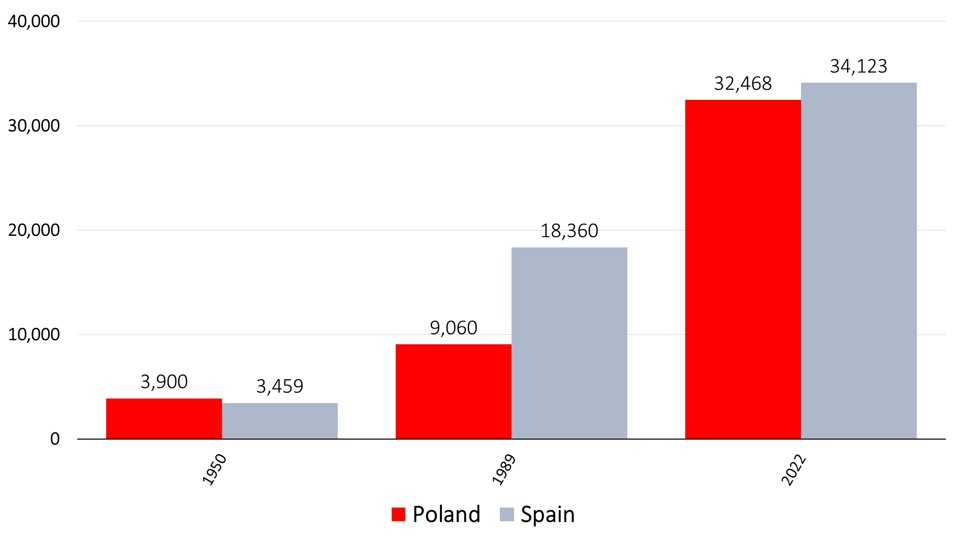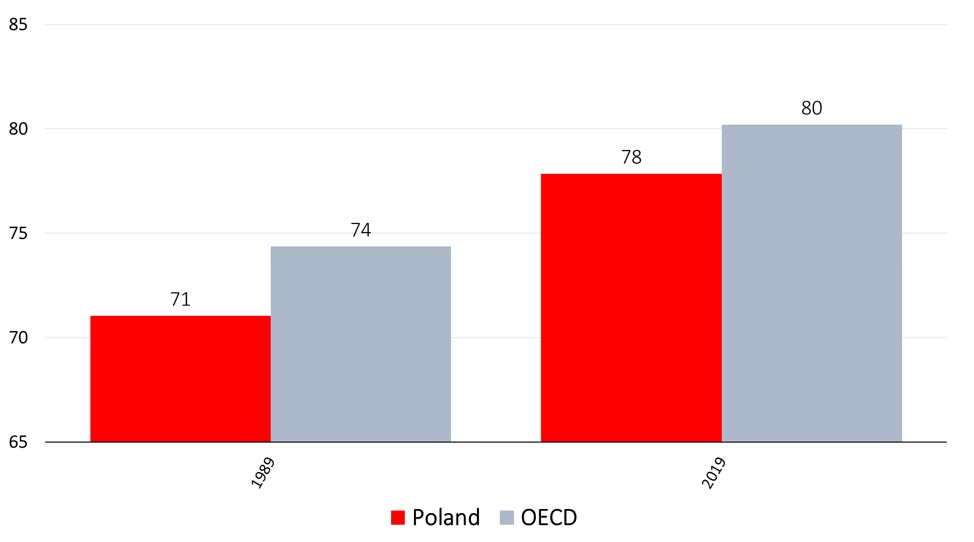On June 4 and 18, 1989, partially free elections for the Sejm and fully free elections for the reconstituted Senate were held in Poland. As a result of these elections, a democratic political system was established, and decisive economic reforms were initiated between 1989 and 1990, which included stabilization and free-market changes. Poland was the first socialist country to begin departing from the system imposed by force, which was flawed.
After 45 years of socialism, the country’s economic situation was exceptionally bad even compared to other socialist countries. Poland was one of the poorest countries in Europe, poorer than some African countries. In the 1980s, it received humanitarian aid from Western Europe.
Because of economic stabilization and free-market transformation, Poland has been narrowing the gap with the West for the past 35 years. In 1989, Polish GDP per capita was only 37% of the OECD average; by 2022, it had reached 81% of the average.
Past successes, however, do not guarantee continued growth. In order to further narrow the gap with the West, Poland needs to complete the freedom-oriented economic reforms that have not been implemented in the past eight years.
Road to Elections
At the end of the 1980s, the economic situation of the Polish People’s Republic was terrible, even compared to other socialist countries. The cumulative GDP growth between 1979 and 1989 was only 1.1%, and the Polish state had incurred foreign debt amounting to approximately $46 billion (equivalent to about 70% of GDP).
In 1987-1988, the Polish United Workers’ Party (PZPR) and Messner’s government attempted to save their power by implementing economic reforms. Obviously, these reforms could not succeed as they assumed the continuation of the socialist dogma – dominance of state ownership in the economy. Price increases triggered another wave of strikes, and society demanded the re-legalization of “Solidarity”.
The PZPR leadership initiated dialogue with the Solidarity side, including Lech Wałęsa. The later government of Mieczysław Rakowski, a communist party liberal, allowed private economic activity (the so-called Wilczek Act). This was an important but insufficient step towards capitalism – the overwhelming majority of the economy was still to be constituted of inefficient state-owned enterprises.
Authorities decided to engage in a broad dialogue with the democratic opposition. On February 6, 1989, the Round Table talks began. The elections of June 4, 1989, were held under its agreements – 299 (65%) seats in the Sejm were guaranteed to candidates from the PZPR and its satellites, while 161 (35%) were to be filled through free elections. Elections to the reconstituted Senate were to be completely free.
Ultimately, after two rounds of voting (on June 4 and 18), “Solidarity” achieved an overwhelming victory. All seats in the free elections to the Sejm and 99 out of 100 seats in the Senate were filled by representatives of the democratic opposition. After a brief attempt by the PZPR and its satellite parties to form a government under General Kiszczak, the first non-communist government in the Eastern Bloc after World War II was established – the government of Tadeusz Mazowiecki. The social, economic, and political reforms undertaken by this cabinet paved the way for Poland’s freedom and the rapid recovery of the 45 lost years due to the establishment of socialism.
Economic Situation after PRL
The Polish People’s Republic left a country with a ruined economy. In 1989, Poland was in the worst condition among all socialist countries. In addition to the dramatically low GDP per capita, the problems included high foreign debt and hyperinflation.
Chart 1: Inflation in 1989
In 1990, Poland had a lower GDP per capita measured by purchasing power parity than all European countries except Belarus, Albania, and Romania. Lower also than[1]:
| • Uruguay
• Suriname • Brazil • Algeria • Iran |
• Mexico
• Turkey • Venezuela • Gabon |
By 2021, Poland had surpassed all the abovementioned countries, as well as, among others:
| • Hungary
• Portugal • Greece • Latvia • Slovakia |
• Bulgaria
• Argentina • Ukraine • Russia |
Chart 2: Percentage Growth of Real GDP per Capita from 1989 to 2020
Closing Gap
Since 1989, Poland has continuously been on a growth path. The swift reforms of Mazowiecki’s government later enabled the fastest growth among all post-socialist countries. It is worth noting that the decline in GDP and the crisis that occurred in Poland during the initial transformation period (the so-called transformational recession) was neither deeper nor longer than in other Eastern Bloc countries, and Poland was the first post-socialist country whose economy began to grow.
Balcerowicz’s Plan is sometimes criticized for its high “social costs”. This is a classic example of confusing cause and effect. The crisis was not caused by the implementation of market reforms – the reforms were a response to the crisis caused by the inefficiency of the socialist system. The response was successful, as inflation was quickly brought under control and the economy soon embarked on a growth path.
Chart 3: GDP per Capita by Purchasing Power Parity of Poland as a Percentage of Germany and the OECD
Transformation brought not only rapid economic development. Beyond the obvious benefits, such as incomparably greater personal freedoms and the ability to move freely beyond the country’s borders, etc., the transformation has brought improvements in various quality-of-life indicators. These include increased life expectancy, decreased infant mortality, reduced CO2 emissions and pollution, and improvements in many other metrics that impact our quality of life.
Chart 4: GDP per Capita of Poland and Spain in 2011 Dollars in 1950, 1989, and 2022
Chart 5: Average Life Expectancy in Years
Future
The increase in wealth observed over the past 35 years is not guaranteed to last forever. It could end if poor economic policies continue. Over the last eight years, the PiS government has reversed the reforms that enabled us to achieve this unprecedented success in our history. Just as 35 years ago, society should demand from those in power to implement responsible policies based on solutions that allowed the Polish economy to achieve rapid development: departing from state ownership in the economy, sensible fiscal policy, expanding economic freedom, increasing the rule of law, and removing trade barriers with foreign countries.
Written by Bartłomiej Jabrzyk








